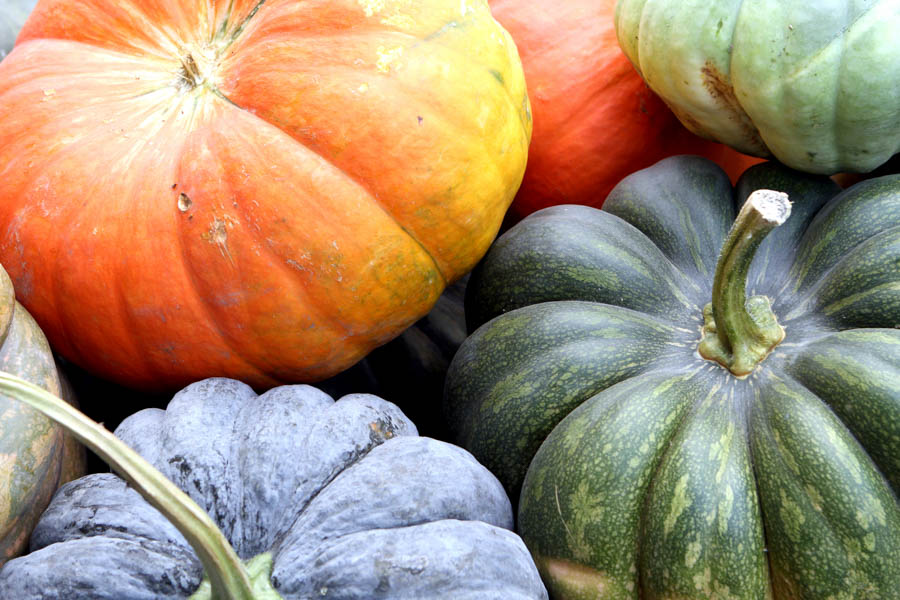Heirloom Pumpkin Varieties: Recommendations and Timing

GardenZeus earns commissions on sales made through links in this article. There is no additional cost to you.
Growing your own pumpkins allows you to enjoy many interesting, unusual, novelty, and delicious varieties that may be difficult or impossible to find in supermarkets or even farmers markets. Heirloom varieties are ideal as ornamentals or pumpkins for Halloween and fall decoration, then cooked and eaten as squash that are much more flavorful and versatile than most pumpkins grown or sold for decoration.
Here are our three of our favorite heirloom varieties:
The Cucurbita moschata heirloom pumpkin variety Musquee de Provence produces large, beautiful, widely and deeply ribbed, flat pumpkins of 5 to 20 pounds that can be carved but are ideal for soups, pies, and other cooking. Pumpkins from this exceptional variety are primarily dark orange but have shades of green, brown, and yellow. Musquee de Provence fruits are a dream of autumn and Thanksgiving captured in vegetable form. This variety is somewhat heat tolerant. Pumpkins store well for several months. 120 days.
French Cinderella or Rouge Vif e’Etampes heirloom produces classic wider-than-tall ribbed pumpkins that have provided inspiration for many an animated fairytale or fantasy artwork. French Cinderella produces deeply ribbed fruits in luscious shades of light orange to deep orange-red. Fruits may grow to 18 inches or more wide and 8 to 25 pounds and store well for months. More prone to insect problems than moschata types.110 days.
For color options other than orange, try Jarrahdale, an heirloom maxima type that produces ribbed, blue-grey fruits in the range of about 3 to 12 pounds, and is excellent for baking after being used for decoration. Stores well for months. More prone to insect problems than moschata types. 100 days.
Growing requirements:
Purchase pumpkin seeds, not seedlings. Pumpkins should generally be seeded directly outdoors.
Pumpkins are heavy feeders that benefit from well-drained, loose, fertile soil with sufficient calcium and moderate-to-high organic matter. Avoid growing any squash or pumpkin varieties in the same place for more than one season at a time to avoid depleting soil and concentrating pest populations and diseases.
As long as fertility and drainage are sufficient, most pumpkin varieties perform well in a variety of soils. Pumpkins are less fussy than some vegetables about soil acidity, and perform reasonably well in the range of about 5.8 to 6.9 pH.
Pumpkins need full sun and sufficient space in soil that is consistently moist but not wet. They do well in raised beds with southern and western exposures.
Ideal temperature range for germination is 70° to 95°F with fastest germination at the warmer end of this range. Ideal temperature range for growth and fruiting is about 65° to 75°F. Most pumpkin varieties withstand temperatures up to 100°F, but growth and fruiting may be diminished at temperatures above 85°F, and flowers may drop at high temperatures. Most varieties grow slowly or not at all at temperatures below 60°F.
Timing:
Gardeners who want to grow pumpkins for Halloween and fall decorations should pay careful attention to timing. Because of their long time to maturity, many gardeners will want to start pumpkin seeds in late April to May to ensure fully ripe pumpkins by early September. Gardeners who may be happy with harvesting pumpkins in October can delay planting. For more thoughts on how to time in hot summer areas see Timing for Growing Halloween Pumpkins in Hot-Summer California Areas.
GardenZeus has customized growing information for pumpkin by zip code. To get started, enter your zip code here.
Other articles of interest:
Storing and Using Freshly Harvested Pumpkin
Growing Winter Squash and Pumpkins in the California Home Garden


